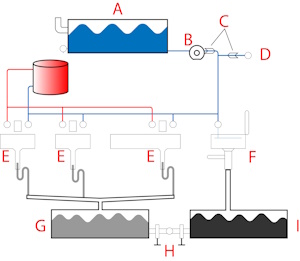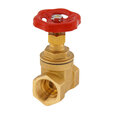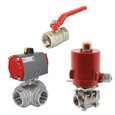Motorhome Waste Water Valves
Figure 1: Disposal of gray wastewater from a motorhome. A sewer line connects to the wastewater outlet into the dump station.
Wastewater drain valves in motor vehicles or recreational vehicles (RVs) are crucial for managing the discharge of gray and black water from the RV's holding tanks. Knowing how these valves work, how to use them correctly, and how to maintain them is vital for maintaining hygiene and complying with environmental laws. This article explores the role of RV wastewater valves, provides installation tips, and outlines criteria for choosing the right valves, equipping RV owners with the information needed to efficiently manage their systems.
Table of contents
- Purpose of wastewater valves
- Installation
- Motorhome waste water valve types
- Selection criteria
- Other factors
- FAQ
View our online selection of ball valves and gate valves!
Purpose of wastewater valves
Motorhome waste water valves are essential components in an RV's plumbing system. They serve two main purposes:
- Controlling the flow of wastewater: The valves act as gates, opening and closing to allow wastewater from the gray and black tanks (discussed later) to be dumped at waste disposal stations. Keeping the valves closed when not dumping prevents leaks and unpleasant odors.
- Preventing backflow: The valves are designed to prevent wastewater from flowing into the RV's plumbing system. This is crucial for hygiene and to avoid damage to the plumbing components. In this context, 'backflow' means waste movement from the tanks to the interior plumbing. The backflow in an RV can be caused by full tanks, improperly sealed valves, sloped parking, and blockages in the sewer hose.
Installation

Figure 2: RV plumbing system: fresh water tank (A), water pump (B), pump and city water inlet check valves (C), city water inlet (D), sink/shower (E), toilet (F), gray water tank (G), dump valves (H), and black water tank (I).
In a motorhome, the wastewater management valves (Figure 2 labeled H) are typically installed at the outlet of the waste holding tanks.
- Black water tank valve: This valve is connected to the black water tank (Figure 2 labeled I), which holds waste from the toilet. The valve is usually located near the bottom of the tank to allow for complete emptying. It's often larger in diameter (typically 3 inches) to accommodate the passage of solid waste.
- Gray water tank valve: The gray tank (Figure 2 labeled G) collects water from the sinks and shower (Figure 2 labeled E). The valve for the gray water tank is also located near the bottom of the tank for efficient draining. It may be smaller in diameter (typically 1.5 to 2 inches) since gray water doesn't contain solids like black water.
Both valves are generally located outside the RV. The valves are positioned to be connected to a sewer hose, which transfers the waste from the tanks to a dump station.
The valves can be manually or remotely operated. When it's time to empty the tanks, the RV owner (or operator) connects the sewer hose to the RV's waste fitting, ensures the other end is securely attached to the dump station's inlet, and then opens the valves, typically starting with the black water tank followed by the gray water tank. The gray water helps to flush out any remaining waste from the hose.
Read our RV check valve article for more details on the structure of RV plumbing systems and using check valves at various locations.
Motorhome waste water valve types
In motorhomes, there are typically two types of wastewater valves used for the separate holding tanks:
- Gate valves:Gate valves are the most common for RV wastewater systems. A gate valve consists of a sliding gate or paddle that, when lifted, allows wastewater to flow out of the tank. When closed, it provides a seal to prevent leakage. Gate valves are used because they can handle the thick and potentially solid-laden wastewater from the black tank (toilet waste) and the gray tank (shower, sink water). They are preferred for their simplicity, effectiveness, and ease of use.
- Ball valves:Ball valves have a spherical closure unit with a hole through it. When the handle is turned, the ball rotates to align the hole with the flow path, allowing waste to pass through, or it rotates to block the flow when the valve is closed. Three-piece ball valves are preferable in RV wastewater systems primarily because they allow for easy disassembly, facilitating thorough cleaning and maintenance, which is essential for preventing waste buildup and ensuring hygiene. Ball valves are not as common in RV waste systems because, despite providing a good seal and being durable, they can be more expensive than gate valves and are prone to clogging as solid waste may get trapped around the ball mechanism, leading to blockages and operational issues.
The valves can be operated manually or electrically.
Manual valves
Advantages
- Cost-effective: Less expensive than electric valves, making them a budget-friendly option.
- Simplicity: Straightforward mechanical devices with a simple design and fewer parts that can fail.
- Maintenance: Generally reliable and may only need periodic cleaning or lubrication.
- Installation: Easier to install and replace due to the lack of electrical components.
Disadvantages
- Physical effort: Requires manual force to pull or push a handle or lever, which can be significant if the valve is stiff or in cold weather.
- Accessibility: Often located on the RV's exterior, requiring the user to bend down or reach into tight spaces.
- Weather conditions: Operation can be more challenging in adverse weather, such as extreme cold or inclement weather.
Electric (automatic) valves
Advantages
- Convenience: This can be operated with the push of a button, often from inside the RV, eliminating the need for physical exertion.
- User-friendly: Ideal for individuals with limited mobility or strength, as no manual effort is required.
- Weather conditions: Operation is less affected by adverse weather since it can be done from the comfort of the RV's interior.
Disadvantages
- Cost: Generally more expensive than manual valves, with higher initial investment and potential repair costs.
- Complexity: More components, such as electrical wiring and motors, can increase the potential for malfunctions.
- Power requirement: Depends on the RV's electrical system to operate
- Installation: Installation can be more complex due to the need for electrical integration and additional steps like waterproofing electrical connections.
Selection criteria
Selecting the appropriate valve for a wastewater system in an RV involves considering several technical factors to ensure compatibility, reliability, and ease of use.
- Valve type: Gate valves are often preferred for their simplicity and effectiveness, while ball valves are known for their durability and smooth operation.
- Size and compatibility: The valve must match the size of the existing plumbing and tank outlets. Black water valves are typically 7.6 cm (3 inches) thick to handle solid waste, while gray water valves are usually 3.8 to 5 cm (1.5 to 2 inches). Ensure the new valve is compatible with the existing flanges or fittings.
- Valve type: Manual valves are simple, cost-effective, and reliable but require physical effort. Electric valves offer convenience and ease of use at the push of a button but come with a higher price tag, increased complexity, and the need for a power source.
- Material: Wastewater valves are generally made from durable materials that can withstand exposure to chemicals and solid waste without corroding or leaking. Common materials include ABS plastic, stainless steel, or brass.
- Seal quality: The valve should have a high-quality seal to prevent leaks and odors. Look for valves with durable rubber seals or gaskets that can be easily replaced if they wear out.
- Ease of operation: The valve should be easy to open and close, even when wearing gloves. Handles should be ergonomic and may be extended for easier reach.
- Space constraints: RVs have limited space, so waste water valves must be compact and efficiently designed to fit within the vehicle's undercarriage or service bay.
- Temperature resistance: The valve should withstand temperature extremes, from freezing to high heat. This is particularly important for valves exposed to the external environment.
- Pressure rating: While wastewater systems in RVs don't typically operate under high pressure, the valve should be rated for any pressure it might encounter.
- Ease of maintenance: Look for easy-access valves for maintenance and cleaning. Valves that can be disassembled allow for the replacement of seals and internal parts without removing the entire valve body.
Other factors
- Debris accumulation: The abrasive nature of wastewater can cause debris build-up around the valve seal, hindering smooth operation and potentially creating leaks. Regular cleaning and maintenance are crucial. Regularly use enzyme-based treatments in the holding tanks. These treatments help break down waste and toilet paper, reducing the likelihood of debris clogging the valves.
- Frequency of use: Unlike valves in a residential or commercial plumbing system that may be used daily, RV waste water valves are used intermittently, often with periods of inactivity. This can lead to seals drying out or debris buildup, so the valves must maintain their sealing ability even when not used for some time. Use a plumber's silicone grease or a specialized RV valve lubricant on the seals and moving parts of the valve. This helps maintain the elasticity of the rubber seals and prevents them from drying out. Avoid petroleum-based lubricants, as they can degrade rubber seals.
- Sanitize: After dumping, use a hose to rinse out the sewer hose and the area around the dump station. Wear gloves to protect from contamination.
- Monitor tank levels: Keep an eye on the tank levels so one knows it's time to dump. Most RVs have sensors that show how full each tank is.
FAQ
Where is the gray water valve on an RV?
The gray water valve on an RV is typically located underneath the vehicle, near the gray water holding tank. It is accessible within a service compartment or the tank's outlet.







